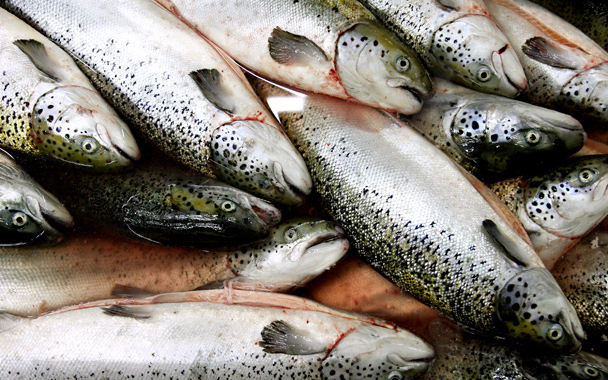As far as I’m concerned, the USDA’s notions about what constitutes organic in seafood are nothing short of consumer fraud.
Last week, the National Organic Standards Board (NOSB), the branch of the United States Department of Agriculture (USDA) that sets organic requirements, proposed criteria whereby carnivorous fish raised in open waters could be sold under the coveted “USDA Organic” label.
A little bit of background. Currently, there is no such thing as USDA organic seafood. The fish you see labeled as organic in supermarkets has usually been certified by a foreign agency whose standards fall far below what Americans consider organic. But organic is now a $23-billion-plus industry, and aquaculture companies are eager for the extra profits conferred by the USDA’s green logo. So the NOSB has been under intense pressure to come up with criteria for seafood, a task it began wrestling with in 2001.
There was no problem defining standards for catfish, tilapia, and other species that can be fed strictly vegetarian diets and raised in non-polluting enclosed ponds. The rules would be similar to those that apply to pigs and chickens: only organic food; no drugs.
But carnivorous species, particularly salmon, raised in open water net pens and fed a diet made up of wild fish (which by definition cannot be called organic because it’s impossible to control their diets and ensure that they come from clean waters) were another story. In addition to not being organic, the small, anchovy-like minnows used to produce the fishmeal for aquaculture are themselves overfished.
There are also problems with net pens themselves. Excrement and uneaten food (along with parasites, drugs, and diseases) flow directly from the pens into the ocean, polluting water and creating “dead zones” of rotting material on the seafloor. When it comes to waste, there is no substantial difference between a fish farm and a hog farm, but a hog producer who pumped manure directly into the ocean would be stripped of organic certification in minutes.
A year ago, 44 leading organizations from the organic, ocean conservation, and food safety communities—everybody from Greenpeace to the Northeast Organic Dairy Producers Association—submitted a letter urging the NOSB not to allow carnivorous fish raised in open pens to be called organic. “Attempting to define organic standards for open pens and wild fish as feed is like attempting to fit a square peg into a round hole—the principles and practices are simply incompatible,” the group wrote.
Earlier this month, the Consumers Union released results of a survey showing that more than 90 percent of American shoppers felt that fish labeled as organic should be fed 100 percent organic feed and that organic aquaculture operations should not dump their sewage directly into the ocean.
But the NOSB chose to ignore public opinion. It gave its blessing to open pens and skirted the issue of inorganic wild fish going into feed by cynically decreeing that fishmeal was not food at all, but a supplement, and therefore permissible in concentrations up to 25 percent. That is like saying that a quarter of a chicken’s diet can be inorganic, yet the bird can be sold as “USDA Organic.” Ironically, a wild salmon caught out of pristine waters, containing virtually no chemical contaminants cannot be called organic.
“Allowing the ‘USDA Organic’ label on a product that does not meet standards for all other organic foods is misleading to consumers and threatens the future of organics,” said Wenonah Hauter of Food and Water Watch in a press release.
Unfortunately, this decision shows that the USDA in its present incarnation has no qualms about misleading consumers and doesn’t care about the future of organics.




 Pinterest
Pinterest


